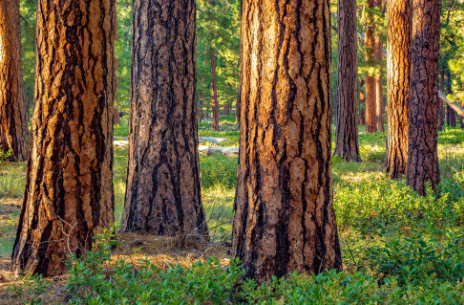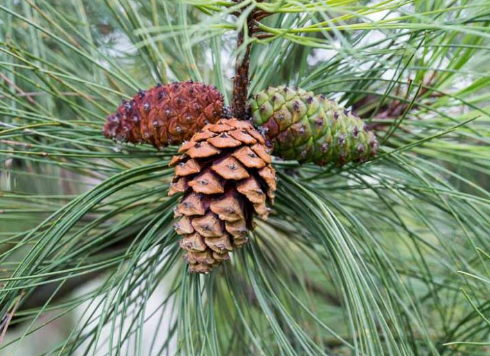
Ponderosa Pines are one of the most widely distributed pine species in North America. They dominate forests in the western United States and Canada, thriving in various climates from semi-arid to more moist regions, though they’re particularly known for their presence in the Rocky Mountains, the Sierra Nevada, and the Black Hills. Ponderosa pine, is also known as bull pine, blackjack pine, western yellow-pine, or filipinus pine.
The name “Ponderosa” was popularized during this time, derived from the Latin word for “heavy” or “ponderous,” referring to the impressive size of the tree. Botanist David Douglas first scientifically described it in the 1820s during his travels in the Pacific Northwest. With westward expansion, the Ponderosa Pine became a prime timber source due to its size, straight growth, and wood quality. The logging industry boomed, especially during the construction of railroads, mining operations, and the rapid development of the American West.
These trees are majestic, often reaching heights of 150 to 230 feet (46 to 70 meters). Their trunks can grow to be over 3 feet in diameter, with some exceptional specimens much larger. In optimal conditions, young Ponderosa Pines can grow quite rapidly. During the first 10 to 20 years, with adequate water, sunlight, and nutrients, they might grow approximately 1 to 2 feet (30 to 60 cm) per year. In ideal conditions, some might even grow up to 3 feet (about 90 cm) annually in their early years.
Ponderosa Pines are long-lived trees, often reaching ages of 300 to 600 years. Once they reach about 50 years or so, the vertical growth might reduce to less than a foot per year. Over time, much of the growth energy is directed towards increasing the girth of the trunk and expanding the root system rather than height.
Ponderosa Pine needles are long, ranging from 5 to 10 inches in length. They are arranged in bundles, or fascicles, usually containing three needles, although some variations might have two or occasionally four needles per bundle. The needles are a deep green, sometimes with a slight yellowish tint, which can give the tree a vibrant yet rugged appearance.This color remains relatively consistent year-round. These needles can stay on the tree for several years, between 3 to 7 years, before they turn brown and fall off. When warmed by the sun, the needles release a fragrance often described as vanilla or butterscotch.

Ponderosa pine cones & Needles
Ponderosa pine cones are large, ranging from 3 to 6 inches in length. They are ovoid (egg-shaped) when open and more conical when closed. When mature, the cones are usually a reddish-brown color. Before maturity, they can be green or purplish. Each cone has scales that are thick and tipped with a sharp prickle, which can be quite noticeable when you handle them.
Ponderosa pines are wind-pollinated. The male cones, which are smaller and often yellowish, release pollen in the spring. After pollination, fertilization can take over a year, which means the cones you see might be from this year’s pollination or last year’s.
Recent history sees Ponderosa Pines facing new challenges with climate change, including shifts in precipitation patterns, temperature increases, and more frequent and severe wildfires. These factors are influencing where Ponderosa Pines can thrive in the future. Cones take about two years to mature. Once mature, the cones open to release seeds, usually triggered by dry, warm conditions, or sometimes by fire.
Varieties of ponderosa pine (Pinus ponderosa)
| Variety | Habitat/Zones |
|---|---|
| Pinus ponderosa var. ponderosa | Widespread in the Rocky Mountains and Pacific Northwest, typically in zones 3-7. |
| Pinus ponderosa var. scopulorum | Found in the Rocky Mountains, especially in Colorado, Wyoming, and the Dakotas, zones 4-7. Often at higher elevations than var. ponderosa. |
| Pinus ponderosa var. benthamiana (also known as P. ponderosa var. pacifica) | Native to the Pacific Coast, particularly in California, in zones 7-9. Sometimes considered synonymous with or closely related to var. ponderosa but often grows in more coastal or lower elevation environments. |
| Pinus ponderosa var. brachyptera | Occurs in the southwestern U.S., like Arizona and New Mexico, zones 6-8. Known for its distinctively shorter needles in bundles. |
| Pinus ponderosa var. washoensis | Limited to the Washoe region of Nevada and adjacent parts of California, zones 6-8. It’s adapted to higher elevations with more moisture |
Environmental Factors
- Soil: Rich, well-drained soils promote faster growth. Poor, rocky, or overly compacted soils can stunt growth.
- Water: While Ponderosa Pines are drought-tolerant once established, regular moisture, especially in the growing season, will result in better growth rates. However, they don’t do well in waterlogged conditions.
- Sunlight: They require full sun for optimal growth. Shaded trees grow much slower. In dense stands where Ponderosa Pines must compete for resources, growth can be significantly slower than in open areas where each tree has ample space, light, and soil resources.
- Elevation: Growth rates can also be influenced by altitude. Trees at lower elevations where temperatures are warmer might grow faster than those at higher, cooler elevations, although this can be moderated by other factors like precipitation and soil.
- Health: Trees free from diseases, pests, and physical damage will naturally grow faster. Ponderosa Pines are susceptible to threats like the mountain pine beetle, which can slow growth or kill trees.
Uses of Pinus ponderosa
- Ponderosa pine wood is highly valued for its strength, straightness, and relative ease of working. It’s used extensively in construction for framing, flooring, and paneling.
- The wood is used in the production of pulp for paper due to its long fibers, which contribute to paper strength.
- It remains a cornerstone of the timber industry in the Western U.S. for both construction and specialty wood products.
- In reforestation efforts, ponderosa pine is planted to help stabilize soils and prevent erosion, especially in areas affected by logging or wildfires.
- The bark and needles can be used as mulch in gardening, helping to retain soil moisture and suppress weeds.
- The needles and wood contain essential oils which can be distilled for use in aromatherapy, cleaning products, and as a natural insecticide.
- Ponderosa pine is often planted as an ornamental tree in parks and larger landscapes due to its aesthetic appeal and size.